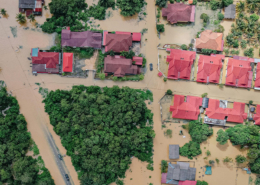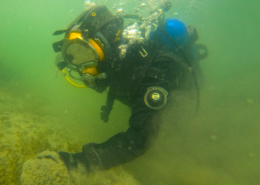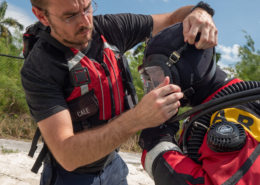Would you lick a dead guy?
By: Jay White
Picture this: Once upon a time… not so long ago in a city near you there was a horrific car accident. The driver suffered catastrophic injuries and was rushed to the hospital. In the emergency room, the ER nurse dons a favorite pair of gloves that they have had for a year and puts them on. They leak a little but they explain to their co-worker that the gloves are broken in and are what they prefer to wear.
The doctor arrives wearing a thin jacket. Then declines to wear a gown, gloves, a mask or face shield. The doctor says their coat is more comfortable than surgical gowns. They claim they do not need a mask or gloves. Why? Because while many people come and go from the ER, no one gets sick. This means the room is clean; there is nothing to worry about.
The doctor and nurse go to work on the victim. Along the way, they become covered in bodily fluids. Afterward, the nurse rinses those favorite gloves in the sink, then hangs them to dry. The doctor goes out behind the hospital, sprays down the contaminated jacket with a garden hose. Once it is dry, wears it when out with family and friends, and to play with their children.
Meanwhile, at the same time as the accident, there is a house fire nearby. The fire department rushes to the scene and learns they may have to enter the burning building to search for a missing person.
As they gear up to enter the building, one firefighter puts on a sweatsuit instead of bunker gear. Explaining that, with the current temperature, it is just too hot to work in heavy protective gear. They then put on a bicycle helmet, a pair of goggles and a filter mask. Stating that it is much lighter, more comfortable and less expensive than an actual helmet and SCBA setup and it is what they prefer to use.
From steel-toed boots, hard hats on construction sites to fall-arrest harnesses and high visibility vests for those working near moving traffic. Personal protective equipment (PPE) has become the standard practice in the working world. This makes scenarios mentioned above appear rather ridiculous. While these two previous stories are completely fabricated, they can reflect what could possibly occur at the scene of a public safety dive operation.
Water is “icky.” This is why public safety divers must protect themselves. The best way to avoid disease and pestilence that is the water we dive in is to ensure the diver is encapsulated. The goal is to ensure no part of the body comes in contact with water. Doing so involves the use of drysuits, dry hoods, dry gloves and full-face masks.
Why encapsulate public safety divers?
Thousands of people swim at public beaches every summer. Few of them get sick from the water. Why then is it necessary to encapsulate public safety divers entering the same water? The reason is the decomposition which occurs in bodies post mortem.
Autolysis (self-digestion) is one of the processes that is part of decomposition. It begins very shortly after the time of death. The body stops producing the mucus necessary to contain the stomach’s digestive acids. Within hours of death, these acids begin to break down internal organs.
This digestive process, coupled with possible tearing of the alveolar tissue during drowning results in blood, body fluids and decomposing organs leaking into the surrounding water. The very water the diver will be swimming in. At this point, in spite of the beach being a well known safe swimming area, the water surrounding the victim is contaminated with biological material. It needs to be treated as such.
The drysuit with dry hood.
A key part of encapsulating a diver is the drysuit to keep the body away from the water. Why don’t all public safety divers use them? Cost is a factor. However, some divers also claim that, in warm climates, drysuits are too warm to use. That’s avoidable.
Public safety divers should use shell-type drysuits instead of neoprene ones. In warm water, neoprene foam suits can cause divers to overheat. They are also hard to decontaminate following dives.
Shell-type drysuits provide little or no insulation in the suit itself and allow divers to layer insulation underneath to accommodate for the water temperature. With layering, divers can use the same drysuits in 32° C/90° F water as they use in -1° C/30° F water.
For true encapsulation, divers must also use a dry hood. Why bother to protect your body from the environment when you are exposing your head and ears? Like shell-type drysuits, dry latex hoods offer very little in the way of insulation. However, by changing the layering underneath from very thin to a full-blown hood liner, divers can adjust for water temperature while keeping heads and ears from being exposed to potentially hazardous contaminants.
Dry gloves
Public Safety divers diving without gloves or with wet gloves will often take the position that their hands have no orifices. As long as you wash your hands after the dive, they claim, there should be no problem. That is often the case, however…
Like most public safety divers, I always have a few nicks and cuts on my hands. In my case, this comes from getting creative in the kitchen after binge-watching the Food Network show Chopped. I do not want those cuts exposed to bodily fluids. Even if there are not cuts, everything I prepare, cook and eat is done with my hands. The more contaminant-free they are kept, the better.
On the other side of the same coin every public safety dive site is a potential crime scene. DNA testing is often part of crime scene processing. This makes cross contamination an issue. Dive teams must take every precaution possible so they do not introduce their own DNA to the scene. A clean set of dry gloves will help prevent this. Ensuring the gloves are clean will also help prevent leaving DNA from a previous victim at the scene.
Rubber gloves with a thin liner provide dexterity and protection. They are an economically viable solution for keeping divers’ hands dry and free from contaminants.
Full-face mask
The full face mask (FFM) is an essential piece of equipment in any public safety dive operation. Even setting aside the whole bonus of underwater voice communications capabilities. There are just too many positives in using one for PSD dives.
Detractors will often cite two issues:
- FFMs can be uncomfortable to wear.
- Their use can increase gas consumption.
Perhaps these potential drawbacks are offset by the importance of keeping contaminated water away from your eyes, nose and mouth. Not ingesting contaminated water is paramount. However, there is no reason to suffer discomfort or increased air use.
- As with any piece of equipment, FFMs require training and practice. This must include proper donning and adjustment to ensure a comfortable fit. This can solve the discomfort issue.
- Most PSD full face masks include voice communications. It is this that increases air consumption. Your basic gas consumption should not change simply because you are using a full-face mask. Buy keeping conversation to a minimum, your air consumption should not be affected.
With proper training and practice, most divers quickly become accustomed to masks that never fog or leak. They also appreciate the ability to breathe through their noses. For these reasons, many public safety divers prefer to use FFMs, even when sport diving with friends.
Encapsulation is key
The days of searching a harbor with a mask and regulator only to have divers surface with toilet paper stuck to their faces must end. So does spending the next three months fighting ear infections. It is just not acceptable in today’s work environment.
We would not expect a police officer to go on the road without soft body armor. Nor would we expect firefighters to enter a burning building without proper equipment. Public safety dive teams should not expect divers to enter the water without being properly encapsulated.
Yes, the gear is more expensive than standard scuba gear. Yes, it requires extra training and practice. However, the health of you and your team is worth it.


 Photo By: Defense Visual Information Distribution Service
Photo By: Defense Visual Information Distribution Service


 Y. ZIN
Y. ZIN


Laisser un commentaire
Rejoindre la discussion?N’hésitez pas à contribuer !